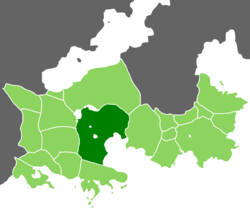Duchy of Suedia
Sovereign Duchy of Suedia | |||||||||||
|---|---|---|---|---|---|---|---|---|---|---|---|
| 520 CE–1075 CE | |||||||||||
|
Flag | |||||||||||
 Suedia (dark green) among other Germanic (light green) in 550 AD | |||||||||||
| Religion | Alban Nazarism Aletheism | ||||||||||
| Demonym(s) | Suedian | ||||||||||
| Government | Monarchy | ||||||||||
| Duke | |||||||||||
• 520-525 | Hermanic | ||||||||||
• 1075 | Odeca (last) | ||||||||||
| Legislature | Suedian Diet | ||||||||||
| History | |||||||||||
• Independence from the Latin Empire | 520 CE | ||||||||||
| 1075 CE | |||||||||||
| |||||||||||
| Today part of | Garima | ||||||||||
The Duchy of Suedia was a Tervingian and Latin successor state centered around the region of the same name in eastern Garima. Suedia was the southernmost province of Gothic-led Tervingian Empire, populated mainly by a different branch of Germanic people : the Suedians who lived from the southern shores of Lake Kulpanitsa to the edge of the Periclean Sea. Despite its size and population the province of Suedia had no representative in the central Thiudathing, remaining a "borderland" for the Gothic Empire.
As Tervingia collapsed due to Ludic migration and forced Decentralization, tribal Suedi leaders became proeminent once more, evolving into petty local warlords. They took the opportunity to rebel in 425 CE and the token military forces sent by Tervingia were defeated at the Battle of Hauptburg leaving the Suedian tribes de-facto independent although conflicts would continue between states who proclaimed to be continuation of Tervingia and those who wished to return to Suedian tribedoms. But military campaigns from the Latins between 440 and 450 CE ended the burgeoning Suedian pirate economy and vassalized most of modern southern Garima and Brumen, securing the Periclean sea. While some forts and ports were built, establishing a token military presence, most of the ruling was left to local Duces, tribal warlords given a place in the Empire' hierarchy in exchange for their submission.
The revolt of the southern goths (505-510 CE) proved the limits of the Latin presence in the Eastern Periclean and spread to the Suedians. Tribal revolts led to Latins having to increasingly rely on local Dukes for repression. The Battle of Osnaburg Forest ended the last hopes of a re-establishment of the Empire' authority and the last Latin settlement in Suedia was abandoned soon after in 520 CE, leaving the region de-facto independent althhough some fiction of a submission to the distant Empire was kept by the early dukes.
For the next three centuries, the dukes of Suedia remained one of the major policy in eastern Belisaria with conflictual relationship with all of its neighbors but Morinia and its Vestrozavans vassals being the Duchy' main rivals. they still had to contend with Sudentor to their east, Nyrundy to their south, and the Duchy of Urnst to their west.
In the late 8th century, the Lushyods arrived in Lake Kulpanitsa, both on boats and by land. While at first profitable to the Suedians - this new migration weakened greatly their northern rival - they would nonetheless fall victims to the Lushyods as well after they settled in the Furodomark in 800 CE, gaining a direct access to Suedia.
The Lushyodorstag proved a dangerous ennemy to Suedia which was forced multiple time to pay tribute to the mounted raiders. They would lose Babenburg to the Lushyods and Elbogen would gain its independence as a vassal-state of the Lushyodorstag. Suedia would retain some geopolitcal weight as part of a Coalition with Morinia, Abodita, and other states against the Lushyods.
During the 11th century Duke Mir of the Suedians died at the battle of Schwaburg against the Holy Aulian Empire. His successor would rule only for a few months before swearing allegiance to the western monarchs, gaining their economic and military support against the Lushyods. This marked the end of Sudia as an independent state. However, the modern day Duchy of Suedia within Garima can be considered the continuation of the old medieval entity.
Government and military
The politics of the Duchy reflected its warlord origins. It was founded by tribal and war leaders who gained their positions through their military might and familial ties. Thus, politics at the court would be dominated by the conflicts between powerful families and individuals with positions passed down from one generation to the next. Beside the Duke and his relatives there were also other strong war aristocrats known as counts who ruled semi-autonomously from the countryside with the support of their respective tribes.
Nonetheless, the Duchy inherited from both Tervingia and the Latins a complex legal system that was shared by all tribes. The early dukes would publish a number of Chapters to simplify, harmonize, and adapt these laws to the new situation of the Duchy. Dukes considered themselves the highest legal authority of their land and would fight fiercely to protect their right to revoke or agree to rulings produced by their vassals and counts.
The Duchy military was mostly an evolution of the Tervingian system adapted to the state' feudal nature. Each settlement, or clan, levied a wedge of roughtly a dozen men. These troops would coalesce into larger parties led by the military aristocracy and their personal permanent retinues. Due to this rather simplistic organisation, relying on tribal links, personal loyalties, and Foraging, Suedians strategies were assymetrical in nature, based on raids, resource management, and rapid action. Fortified castles would become the main defensive and offensive platforms of the Suedi military while Horses dominated the battlefields.
Culture and economy
Suedia was a rural agrarian society dominated essentially by countryside, small hamlets, and forts with only a few medium-sized settlements and none that reached the size of their Morinian rival Tervanna. This explain partly the weak central authority of the Duke and the power held by Alban lauras, vectors of the Duchy' administration and intermediaries between the people and the Duke. These monasteries would become the nucleus of literacy within the Duchy until their destruction by the Holy Aulian Empire.
Without Tervingia or the Latin Empire, trade declined sharply and was limited to direct neighbors with reduced flux. Instead, the basic production unit was the self-sufficient plantation generally associated to an hamlet for the workers and a fort that doubled as the local lord' residence. Economic activities were dominated by the Counts and the Duke' close relations and were often as much economic as politics (embassies...) activities.
